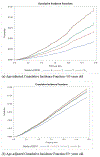Social determinants of health and cancer mortality in the Reasons for Geographic and Racial Differences in Stroke (REGARDS) cohort study
- PMID: 34478162
- PMCID: PMC9301452
- DOI: 10.1002/cncr.33894
Social determinants of health and cancer mortality in the Reasons for Geographic and Racial Differences in Stroke (REGARDS) cohort study
Abstract
Background: Social determinants of health (SDOHs) cluster together and can have deleterious impacts on health outcomes. Individually, SDOHs increase the risk of cancer mortality, but their cumulative burden is not well understood. The authors sought to determine the combined effect of SDOH on cancer mortality.
Methods: Using the Reasons for Geographic and Racial Differences in Stroke (REGARDS) cohort, the authors studied 29,766 participants aged 45+ years and followed them 10+ years. Eight potential SDOHs were considered, and retained SDOHs that were associated with cancer mortality (P < .10) were retained to create a count (0, 1, 2, 3+). Cox proportional hazard models estimated associations between the SDOH count and cancer mortality through December 31, 2017, adjusting for confounders. Models were age-stratified (45-64 vs 65+ years).
Results: Participants were followed for a median of 10.6 years (interquartile range [IQR], 6.5, 12.7 years). Low education, low income, zip code poverty, poor public health infrastructure, lack of health insurance, and social isolation were significantly associated with cancer mortality. In adjusted models, among those <65 years, compared to no SDOHs, having 1 SDOH (adjusted hazard ratio [aHR], 1.39; 95% CI, 1.11-1.75), 2 SDOHs (aHR, 1.61; 95% CI, 1.26-2.07), and 3+ SDOHs (aHR, 2.09; 95% CI, 1.58-2.75) were associated with cancer mortality (P for trend <.0001). Among individuals 65+ years, compared to no SDOH, having 1 SDOH (aHR, 1.16; 95% CI, 1.00-1.35) and 3+ SDOHs (aHR, 1.26; 95% CI, 1.04-1.52) was associated with cancer mortality (P for trend = .032).
Conclusions: A greater number of SDOHs were significantly associated with an increased risk of cancer mortality, which persisted after adjustment for confounders.
Keywords: cancer mortality; health equity; social determinants of health.
© 2021 American Cancer Society.
Figures
Comment in
-
More social determinants lead to more cancer death: A tragic dose response.Cancer. 2022 Jan 1;128(1):39-42. doi: 10.1002/cncr.33890. Epub 2021 Sep 3. Cancer. 2022. PMID: 34478164 No abstract available.
References
-
- ACS. Cancer Facts & Figures 2020. Atlanta, Georgia: American Cancer Society, 2020.
Publication types
MeSH terms
Grants and funding
LinkOut - more resources
Full Text Sources
Medical



